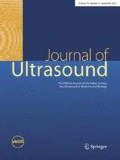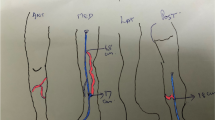Abstract
Purpose
The aim of this study was to investigate the efficacy of shear wave elastography (SWE) in the diagnosis of perforating vein insufficiency, and to determine the applicability of these measurements.
Methods
A total of 140 symptomatic patients with a total of 280 lower extremities were investigated. All patients presented with venous insufficiency (VI) symptoms, and received Doppler ultrasound assessment to determine VI and SWE measurements. The SWE values were measured in the adjacent perivenous tissue of the largest Cockett’s perforating vein (PV) of both lower extremities, at the level where they pass the fascia. The Cockett’s PV diameter and the presence of reflux in Cockett’s PV and the great saphenous vein were compared with SWE values in perivenous tissue of PVs.
Results
The SWE values of the perforating vein insufficiency group were significantly higher than those of the normal PV without insufficiency group (P < 0.001). A significant and positive relation was seen between increased PV diameter and SWE values (P < 0.001) and there was a significant relationship between the presence of perforating vein insufficiency and increase in PV diameter. A statistically significant increase was detected in SWE values for the PV for those with reflux in the great saphenous vein (P < 0.001). The best cut-off values that can be used to detect perforating vein insufficiency were found 34.600 for kPa and 3.375 for m/s.
Conclusion
SWE may be used effectively in addition to conventional Doppler ultrasound examination in diagnosing and following perforating vein insufficiency.





Similar content being viewed by others
References
Van Neer PA, Veraart JC, Neumann HA (2003) Venae perforantes: a clinical review. Dermatol Surg 29:931–942
Rutherford EE, Kianifard B, Cook SJ et al (2001) Incompetent perforating veins are associated with recurrent varicose veins. Eur J Vasc Endovasc Surg 21:458–460
Tolu I, Durmaz MS (2018) Frequency and significance of perforating venous insufficiency in patients with chronic venous insufficiency of lower extremity. Eurasian J Med 50:99–104
Eberhardt RT, Raffetto JD (2014) Chronic venous insufficiency. Circulation 130:333–346
Durmaz MS, Arslan S, Baysal AN et al (2018) Experience of using shear wave elastography imaging in superficial venous insufficiency of the lower extremity. Ultrasound Q 34:176–182
Hattapoğlu S, Göya C, Hamidi C et al (2016) Evaluation of parathyroid lesions with point shear wave elastography. J Ultrasound Med 35:2179–2182
Schillizzi G, Alviti F, D’Ercole C et al (2020) Evaluation of plantar fasciopathy shear wave elastography: a comparison between patients and healthy subjects. J Ultrasound. https://doi.org/10.1007/s40477-020-00474-7
Durmaz MS, Sivri M, Sekmenli T et al (2016) Experience of using shear wave elastography imaging in evaluation of undescended testes in children: feasibility, reproducibility, and clinical potential. Ultrasound Q 34:206–212
Hamidi C, Göya C, Hattapoğlu S et al (2015) Acoustic radiation force impulse (ARFI) imaging for the distinction between benign and malignant thyroid nodules. Radiol Med 120:579–583
Arslan S, Durmaz MS, Erdogan H et al (2019) Two-dimensional shear wave elastography in the assessment of salivary gland involvement in primary sjögren's syndrome. J Ultrasound Med 39:949–956
Durmaz MS, Arslan S, Özbakır B et al (2018) Effectiveness of shear wave elastography in the diagnosis of acute pancreatitis on admission. Med Ultrason 20:278–284
Erdoğan H, Durmaz MS, Özbakır B et al (2020) Experience of using shear wave elastography in evaluation of testicular stiffness in cases of male infertility. J Ultrasound. https://doi.org/10.1007/s40477-020-00430-5
Erdogan H, Durmaz MS, Arslan S et al (2020) Shear wave elastography evaluation of testes in patients with varicocele. Ultrasound Q 36:64–68
Kara T, Ateş F, Durmaz MS et al (2020) Assessment of thyroid gland elasticity with shear-wave elastography in Hashimoto's thyroiditis patients. J Ultrasound. https://doi.org/10.1007/s40477-020-00437-y
Ozgokce M, Batur M, Alpaslan M et al (2019) A comparative evaluation of cataract classifications based on shear-wave elastography and B-mode ultrasound findings. J Ultrasound 22:447–452
Cornelson SM, Ruff AN, Perillat M, Kettner NW (2019) Sonoelastography of the trunk and lower extremity muscles in a case of Duchenne muscular dystrophy. J Ultrasound. https://doi.org/10.1007/s40477-019-00394-1
Durmaz MS, Özbakır B, Cebeci H et al (2018) The cutoff value for the diameter of the saphenous vein in predicting the presence of venous insufficiency. J Turgut Ozal Med Cent 25:135–139
Krnić A, Vucić N, Sucić Z (2005) Correlation of perforating vein incompetence with extent of great saphenous insufficiency: cross sectional study. Croat Med J 46:245–251
Al-Mulhim AS, El-Hoseiny H, Al-Mulhim FM et al (2003) Surgical correction of main stem reflux in the superficial venous system: does it improve the blood flow of incompetent perforating veins? World J Surg 27:793–796
Lawrence PF, Alktaifi A, Rigberg D et al (2011) Endovenous ablation of incompetent perforating veins is effective treatment for recalcitrant venous ulcers. J Vasc Surg 54:737–742
Mendes RR, Marston WA, Farber MA et al (2003) Treatment of superficial and perforator venous incompetence without deep venous insufficiency: is routine perforator ligation necessary? J Vasc Surg 38:891–895
De Maeseneer MG, Pichot O, Cavezzi A et al (2011) Duplex ultrasound investigation of the veins of the lower limbs after treatment for varicose veins-UIP consensus document. Eur J Vasc Surg 42:89–102
Kuyumcu G, Salazar GM, Prabhakar AM et al (2016) Minimally invasive treatments for perforator vein insufficiency. Cardiovasc Diagn Ther 6:593–598
Klem TM, Wittens CH (2008) Cryoperforator surgery: a new treatment of incompetent perforating veins. Vasc Endovasc Surg 42:239–242
Tenbrook JA, Lafrati MD, O’donnell TF et al (2004) Systematic review of outcomes after surgical management of venous disease incorporating subfascial endoscopic perforator surgery. J Vasc Surg 39:583–589
Joh JH, Park HC (2013) The cutoff value of saphenous vein diameter to predict reflux. J Korean Surg Soc 85:169–174
Acknowledgements
We would like to thank Funda Gökgöz Durmaz for providing help in the statistical analysis of the study.
Author information
Authors and Affiliations
Contributions
MSD, UK, BÖ designed and wrote the paper. MSD performed the ultrasound assessment, MSD, HU and UK analyzed the ultrasound images, MSD performed the statistical analysis. All authors read and approved the last version of the manuscript.
Corresponding author
Ethics declarations
Conflict of interest
The authors declare that there are no financial or other relations that could lead to a conflict of interest.
Ethical statements
The approval of the ethics committee (the ethics committee of Selçuk University) was obtained before the initiation of the study. All the participants were previously informed about the study, and a written informed consent was signed by each participant before the US examination. All the procedures performed in the studies on humans were in line with the ethical institutional and/or national research committee standards and with the 1964 Helsinki Declaration and its amendments or comparable ethical standards.
Consent to participate
Writen informed consent was obtained from the patients.
Consent to publish
The authors affirm that human research participants provided informed consent to publish images.
Code availability
Analyses in IBM SPSS statistics were performed without syntaxes, outputs are available by request.
Additional information
Publisher's Note
Springer Nature remains neutral with regard to jurisdictional claims in published maps and institutional affiliations.
Rights and permissions
About this article
Cite this article
Durmaz, M.S., Kesimal, U., Ünal, H.A. et al. Evaluation of perforating venous insufficiency with shear wave elastography: a preliminary study. J Ultrasound 24, 463–470 (2021). https://doi.org/10.1007/s40477-020-00527-x
Received:
Accepted:
Published:
Issue Date:
DOI: https://doi.org/10.1007/s40477-020-00527-x




